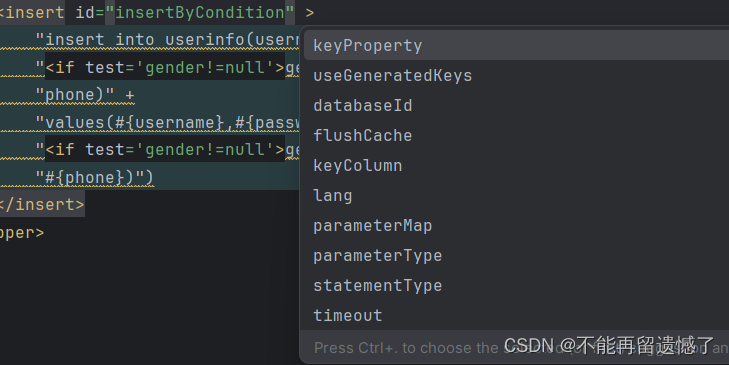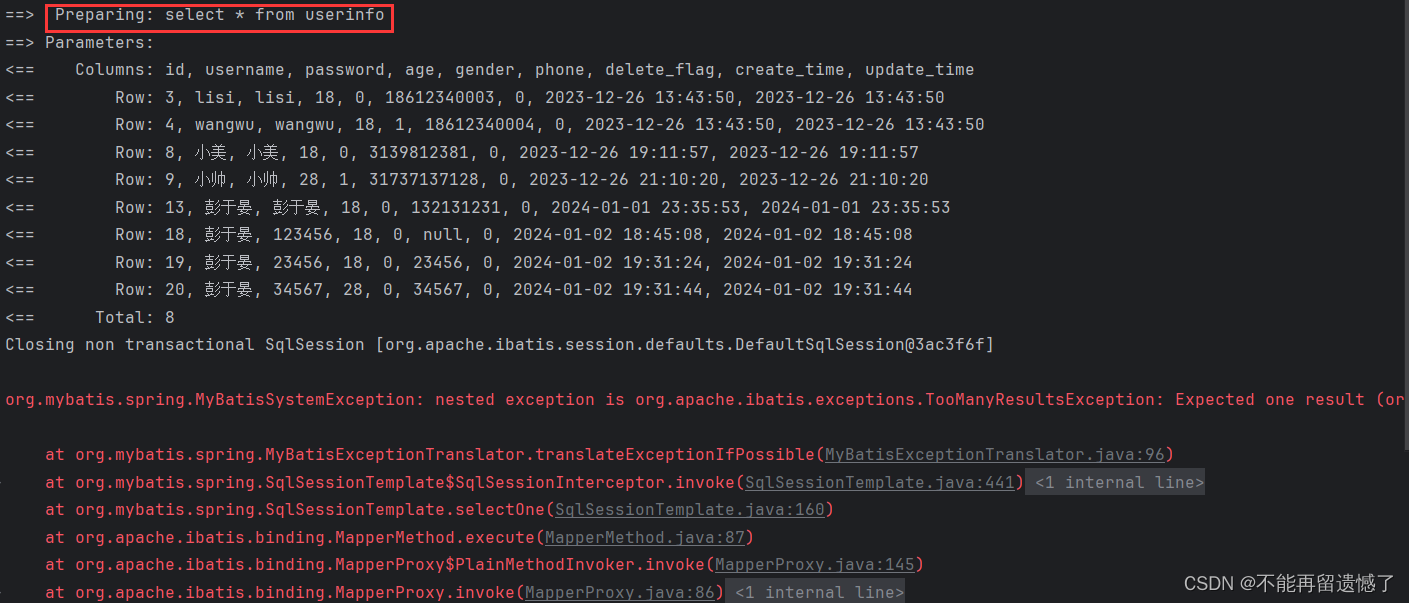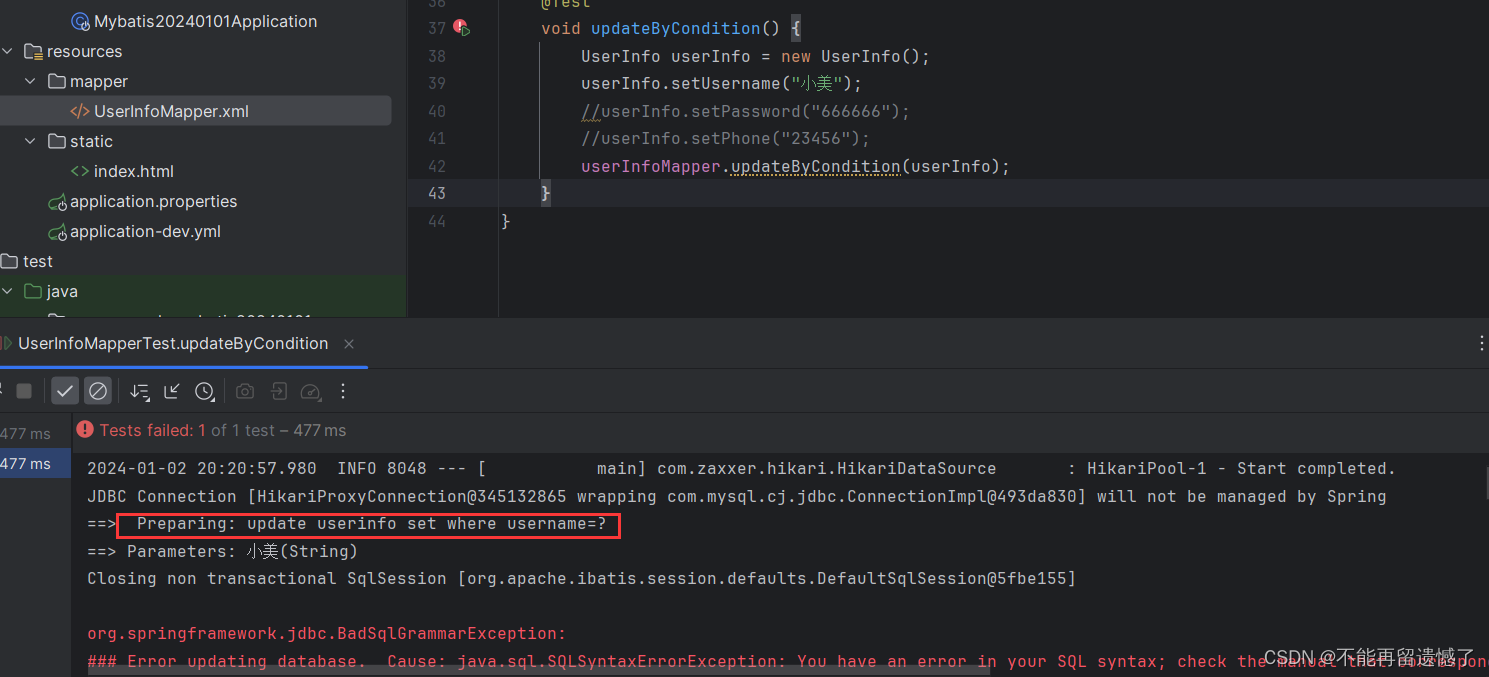【MyBatis】动态SQL

前言
动态 SQL 是 MyBatis 的强大特性之一。如果你使用过 JDBC 或其它类似的框架,你应该能理解根据不同条件拼接 SQL 语句有多痛苦,例如拼接时要确保不能忘记添加必要的空格,还要注意去掉列表最后一个列名的逗号。利用动态 SQL,可以彻底摆脱这种痛苦。具体的定义大家可以参考官方文档MyBatis动态SQL。这篇文章我们将结合动态SQL完成更加复杂的 SQL 操作。
增加操作
想必大家肯定遇到过注册某个账号的时候需要输入自己的相关信息,其中这些信息包括:必填信息和非必填信息,对于这些必填信息,我们只需要在创建表的时候将这个字段设置为非 null 就可以了,而对于那些非必选的选项,我们又该如何定义呢?
这时就需要我们使用动态标签来判断了,对于这些可以传递值和可以不传递值的字段,我们可以使用 <if> 标签来修饰:
@Insert("insert into userinfo(username,`password`,age," +
"<if test='gender!=null'>gender,</if>" +
"phone)" +
"values(#{username},#{password},#{age}," +
"<if test='gender!=null'>gender,</if>" +
"#{phone})")
public Integer insertByCondition(UserInfo userInfo);
<if test="">123</if> 这个标签中 test 表示的是判断,当 test 参数中的判断为真时,那么这个标签的结果就为 <if> </if>标签之间的代码块,在这里就是123;如果 test 中的代码块的判断为假的时候,那么这个<if> 标签的结果就是空。
@Test
void insertByCondition() {
UserInfo userInfo = new UserInfo();
userInfo.setUsername("彭于晏");
userInfo.setPassword("123456");
userInfo.setAge(18);
userInfo.setPhone("132131231");
int ret = userInfoMapper.insertByCondition(userInfo);
log.info(ret + "被更新");
}
然后我们调用这个方法的时候,可以不为 gender 字段传递值,如果不传递值,那么这个字段的值就为创建表时定义的默认值,也可以传递值。然后我们运行一下看能达到效果吗?

这里为什么会报错呢?因为 <if> 标签是属于 JavaScript 的,所以我们需要使用到 <script> 标签。
@Insert("<script>" +
"insert into userinfo(username,`password`,age," +
"<if test='gender!=null'>gender,</if>" +
"phone)" +
"values(#{username},#{password},#{age}," +
"<if test='gender!=null'>gender,</if>" +
"#{phone})" +
"</script>")
public Integer insertByCondition(UserInfo userInfo);

有人会问了,使用 <if> 标签和不使用作用不是一样的吗?对于当前插入数据操作作用是一样的,但是如果我们进行的是修改操作的话,因为我们不知道用户需要修改什么信息,所以我们在写修改操作的话,就需要将所有的字段的修改操作都写上,但是如果我们不使用 <if> 标签的话,并且用户在修改的时候,某个信息没有修改话,后端SQL预处理之后是这样的:update userinfo set username=?, password=?, gender=?, phone=? where username=?,前端传递来的参数是这样的:null, null, null, 123456, 小美,也就是用户只是修改了电话号码这个字段,但是因为没有使用 <if> 标签,所以其他的字段就会被修改为 null,这就会出现问题了。而使用 <if> 标签就会这样处理:update userinfo phone=? where username=?,参数传递:123456, 小美。
上面是使用注解的方式来实现 MyBatis 的,实现 MyBatis 不仅可以通过注解来实现,也可以通过 XML 的格式实现。我们看看 XML 如何实现动态 SQL。
首先我们需要告诉 MyBatis 我们的 xml 文件在哪里:
mybatis:
mapper-locations: classpath:mapper/**Mapper.xml
然后在 XML 文件中写入下面代码,SQL 语句写在 <mapper> 标签中。
<?xml version="1.0" encoding="UTF-8"?>
<!DOCTYPE mapper PUBLIC "-//mybatis.org//DTD Mapper 3.0//EN"
"http://mybatis.org/dtd/mybatis-3-mapper.dtd">
<mapper namespace="com.example.mybatis20240101.mapper.UserInfoMapper">
</mapper>
这里 namespace 的值是我们是使用了 MyBatis 框架操作数据库的类的全限定类名称。
<insert id="insertByCondition">
insert into userinfo(username,`password`,age,
<if test="gender!=null">
gender,
</if>
phone)
values(#{username},#{password},#{age},
<if test="gender!=null">
#{gender},
</if>
#{phone})
</insert>
因为 XML 文件本身就支持 JavaScript,所以我们这里不需要添加 <script> 标签,不仅如此,使用 XML 文件的方式写 MyBatis 还会有提示,所以书写动态 SQL 建议使用 XML 文件格式。

但是使用 <if> 标签也会存在问题,假设我们将 phone 字段也设置为动态的,并且在传递值的时候不传递 phone 的话就会出现问题。
<insert id="insertByCondition">
insert into userinfo(username,`password`,age,
<if test="gender!=null">
gender,
</if>
<if test="phone!=null">
phone
</if>)
values(#{username},#{password},#{age},
<if test="gender!=null">
#{gender},
</if>
<if test="phone!=null">
#{phone}
</if>)
</insert>
@Test
void insertByCondition() {
UserInfo userInfo = new UserInfo();
userInfo.setUsername("彭于晏");
userInfo.setPassword("123456");
userInfo.setAge(18);
//userInfo.setPhone("123456");
int ret = userInfoMapper.insertByCondition(userInfo);
log.info(ret + "被更新");
}

可以看到,因为 phone 是我们定义增加操作时候的最后一个字段,在这里将 phone 设置为动态的,并且在传递值的时候没有传递 phone,那么在拼接 SQL 的时候 insert into userinfo() values() 中两个括号中一定会是以逗号结尾,那么这样的 SQL 就是不和规则的 SQL,那么如何解决呢?这里就需要用到 <trim> 标签了。
<trim>标签
trim 标签在 MyBatis 中主要用于处理 SQL 语句,以去除多余的关键字、逗号,或者添加特定的前缀和后缀。这在进行选择性插入、更新、删除或条件查询等操作时非常有用。
trim 标签有以下属性:
- prefix:表?整个语句块,以prefix的值作为前缀
- suffix:表?整个语句块,以suffix的值作为后缀
- prefixOverrides:表?整个语句块要去除掉的前缀
- suffixOverrides:表?整个语句块要去除掉的后缀
因为我们这里是语句块末尾出现了多余的逗号,所以我们配置 suffixOverrides 属性来删除多余的逗号。
<insert id="insertByCondition">
insert into userinfo
<trim prefix="(" suffix=")" suffixOverrides=",">
username,`password`,age,
<if test="gender!=null">
gender,
</if>
<if test="phone!=null">
phone
</if>
</trim>
values
<trim prefix="(" suffix=")" suffixOverrides=",">
#{username},#{password},#{age},
<if test="gender!=null">
#{gender},
</if>
<if test="phone!=null">
#{phone}
</if>
</trim>
</insert>

查询操作
大家在肯定在网上买过手机吧,当我们买手机的时候,往往会加上一些限制条件。

而这种加上限制条件的查询就可以看成是 select 后面加了 where 语句,但是由于不知道用户需要加上多少查询时候的限制条件,所以这里就可以使用到动态 SQL。
UserInfo selectByCondition(UserInfo userInfo);
<select id="selectByCondition" resultType="com.example.mybatis20240101.model.UserInfo">
select * from userinfo
where
<if test="username!=null">
username=#{username}
</if>
<if test="password!=null">
and password=#{password}
</if>
<if test="age!=null">
and age=#{age}
</if>
<if test="phone!=null">
and phone=#{phone}
</if>
</select>
@Test
void selectByCondition() {
UserInfo userInfo = new UserInfo();
userInfo.setUsername("彭于晏");
userInfo.setPhone("34567");
log.info(userInfoMapper.selectByCondition(userInfo).toString());
}

当然这里也会出现问题,就是当第一个 where 子句没有传递值的话,那么 where 子句中就会多一个 and 在开头。
@Test
void selectByCondition() {
UserInfo userInfo = new UserInfo();
//userInfo.setUsername("彭于晏");
userInfo.setPhone("34567");
log.info(userInfoMapper.selectByCondition(userInfo).toString());
}

为了解决问题,可以使用 <trim> 标签删除前面多余的 and:
<select id="selectByCondition" resultType="com.example.mybatis20240101.model.UserInfo">
select * from userinfo
where
<trim prefixOverrides="and">
<if test="username!=null">
username=#{username}
</if>
<if test="password!=null">
and password=#{password}
</if>
<if test="age!=null">
and age=#{age}
</if>
<if test="phone!=null">
and phone=#{phone}
</if>
</trim>
</select>

<where>标签
这里是解决了 where 子句中开头出现多余的 and,如果我们一个限制条件都不加入呢?
@Test
void selectByCondition() {
UserInfo userInfo = new UserInfo();
//userInfo.setUsername("彭于晏");
//userInfo.setPhone("34567");
log.info(userInfoMapper.selectByCondition(userInfo).toString());
}

这样就会出现问题,那么这样如何解决呢?MyBatis 为我们提供了 <where> 标签用来解决查询语句的 where 子句出现的各种问题,包括开头出现的多余的 and 和 where 子句无内容的情况。
<select id="selectByCondition" resultType="com.example.mybatis20240101.model.UserInfo">
select * from userinfo
<where>
<if test="username!=null">
username=#{username}
</if>
<if test="password!=null">
and password=#{password}
</if>
<if test="age!=null">
and age=#{age}
</if>
<if test="phone!=null">
and phone=#{phone}
</if>
</where>
</select>

可以看到,当我们 where 子句为空的时候,使用 <where> 标签会自动删除 where 子句,它也可以帮助我们删除多余的 and,下面的报错咱们不管,这时因为我们没加 where 子句,所以就相当于查询整个表,但是我们方法的返回值是 UserInfo,改为列表就可以了。
当 where 子句为空的时候,我们还有一种解决方式,就是自己加上一个 1=1 的条件,这样当我们加的条件为空的时候就不会出现错误。
<select id="selectByCondition" resultType="com.example.mybatis20240101.model.UserInfo">
select * from userinfo
where 1=1
<trim prefixOverrides="and">
<if test="username!=null">
username=#{username}
</if>
<if test="password!=null">
and password=#{password}
</if>
<if test="age!=null">
and age=#{age}
</if>
<if test="phone!=null">
and phone=#{phone}
</if>
</trim>
</select>
修改操作
这个修改操作就是前面我们举的一个例子,我们并不知道用户会修改哪些信息,所以我们这里就需要使用到动态 SQL 来解决这个问题。
void updateByCondition(UserInfo userInfo);
<update id="updateByCondition">
update userinfo set
<if test="password!=null">
password=#{password},
</if>
<if test="age!=null">
age=#{age},
</if>
<if test="gender!=null">
gender=#{gender},
</if>
<if test="phone!=null">
phone=#{phone}
</if>
where
<if test="username!=null">
username=#{username}
</if>
</update>
@Test
void updateByCondition() {
UserInfo userInfo = new UserInfo();
userInfo.setUsername("小美");
userInfo.setPassword("666666");
userInfo.setPhone("23456");
userInfoMapper.updateByCondition(userInfo);
}

<set>标签
为了解决 set 中出现的 set 子句中多余的逗号的问题,可以使用 <set> 标签。

<update id="updateByCondition">
update userinfo
<set>
<if test="password!=null">
password=#{password},
</if>
<if test="age!=null">
age=#{age},
</if>
<if test="gender!=null">
gender=#{gender},
</if>
<if test="phone!=null">
phone=#{phone}
</if>
</set>
<where>
<if test="username!=null">
username=#{username}
</if>
</where>
</update>
如果 set 子句为空的时候,是会报错的,通过 <set> 标签无法解决,我们应该避免用户 set 输入空的子句。
删除操作
<foreach>标签
当我们想要在删除的时候删除不定数量的条件时,delete from userinfo where name in("小美","小帅"),因为条件的数量是不确定的,所以我们在定义的时候就不知道 where 子句后面有多少个,所以这里我们就需要用到 <foreach> 标签。
<foreach> 标签可以对集合进行遍历,标签具有以下属性:
- collection:绑定?法参数中的集合,如 List,Set,Map或数组对象
- item:遍历时的每?个对象
- open:语句块开头的字符串
- close:语句块结束的字符串
- separator:每次遍历之间间隔的字符串
void deleteByCondition(List<Integer> list);
<delete id="deleteByCondition">
delete from userinfo
where id in
<foreach collection="list" item="id" open="(" close=")">
#{id}
</foreach>
</delete>
@Test
void deleteByCondition() {
userInfoMapper.deleteByCondition(Arrays.asList(13,18,19,20));
}

<include>标签
在xml映射?件中配置的SQL,有时可能会存在很多重复的?段,此时就会存在很多冗余的代码

我们可以对重复的代码?段进?抽取,将其通过 <sql> 标签封装到?个SQL?段,然后再通过
<include> 标签进?引?。
ArrayList<UserInfo> selectAll();
<sql id="allColumn">
id, username, age, gender, phone, delete_flag, create_time, update_time
</sql>
<select id="selectAll" resultType="com.example.mybatis20240101.model.UserInfo">
select
<include refid="allColumn"></include>
from userinfo
</select>
@Test
void selectAll() {
log.info(userInfoMapper.selectAll().toString());
}

这样就可以减少很多重复的代码。
本文来自互联网用户投稿,该文观点仅代表作者本人,不代表本站立场。本站仅提供信息存储空间服务,不拥有所有权,不承担相关法律责任。 如若内容造成侵权/违法违规/事实不符,请联系我的编程经验分享网邮箱:chenni525@qq.com进行投诉反馈,一经查实,立即删除!
- Python教程
- 深入理解 MySQL 中的 HAVING 关键字和聚合函数
- Qt之QChar编码(1)
- MyBatis入门基础篇
- 用Python脚本实现FFmpeg批量转换
- 【前后端的那些事】解放后端!10min快速上手人人代码生成器(后端篇)
- C. Load Balancing 一个序列同时加一个数和减一个数,直到最大和最小之间相差最大为1(结论可记住)
- k8s的hpa
- 网盘项目话术(0.5w字精选)
- 设计模式—— 单例设计模式
- Redis List:打造高效消息队列的秘密武器【redis实战 一】
- 8个Python必备的PyCharm插件
- LabVIEW在齿轮箱故障诊断中的应用
- vue3引入百度地图(两种方法)
- HPA 自动伸缩